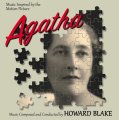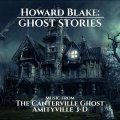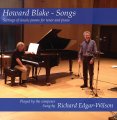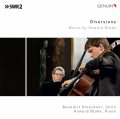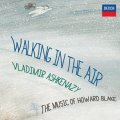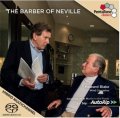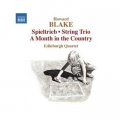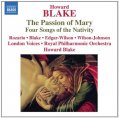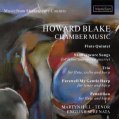 Highbridge Music Ltd.
Highbridge Music Ltd.
Studio 6, 18 Kensington Court Place, London W8 5BJ, UK
Email: howard@howardblake.com
ELEGIA STRAVAGANTE, DUO CONCERTANTE FOR SOLO VIOLIN, SOLO CELLO AND ORCHESTRA op.686 (February 2017)
A double concerto for soloists and orchestra (adapted from the Piano Trio no. 3, composed 2014)
Published by: highbridge musicCommissioned by: Benedict Kloeckner
Instrumentation:
solo violin, solo cello, 1 flute, 1 ob, 2 clars, 2 bsns, 4 hns, 1 pc, strings
[Key to Abbreviations]
Duration: 16 mins
First Performance: Cadogan Hall Sept.7th 2017. Benedict Kloeckner cello and Nicolas Dautricourt violin with The Royal Philharmonic Orchestra conducted by the composer
Sheet Music Available
Full score for saleStudy score for sale
Orchestral parts for sale
Full score for hire
Study score for hire
Orchestral parts for hire
Movements
-
1:
Andante (rapsodico)
On the afternoon of October 28th 2013, after rehearsing with the cellist Benedict Kloeckner, we talked for a while about double concertos and pondered as to how one might create one. Shortly afterwards I slept for a while and dreamed up first a septuplet 'trill-flourish' motif in C major and then an ensuing 'upward-sweeping' melodic fragment of a minor 2nd and major 7th, both of which I immediately wrote down. I felt at once that this was material ideally suited for violin and cello with piano or orchestral accompaniment and wrote what was to be the first movement as a rhapsodic Andante.
-
2:
I then felt I needed some sort of 6/8 allegro idea as a bridge passage and worked at several until I suddenly remembered a sort of 'jazz fugue' from an early work called 'Movement for orchestra' which I'd once had played by The Royal Philharmonic Orchestra. It seemed to fit perfectly here, and with some revision formed a perfect link between the Andante (rapsodico) and the next section Tragico.
-
3:
Tragico
Tragico begins with the upward-sweeping motif, but now very slow and sad. This forms a bridge and modulation to E-minor where the cello enunciates the theme 'Parting', a fragment I had dreamt up in the summer whilst preparing repertoire for Vladimir Ashkenazy's album of my piano works. But here the 'Parting' theme develops greatly, leading quite rapidly and unexpectedly to a colossal climax, then falling down to a paused low chord of C major which begins section 4.
-
4:
Grave, molto espressivo
Grave molto espressivo is a deeply-felt cadenza for violin and cello which then starts to accelerate (piu mosso) towards section 5
-
5:
Allegro furioso
Cello and violin play in unison at the 16th against a constantly turning orchestral phrase using the ever-present 'trill-flourish' motif. Martial and tragic hints and twists are now overcome by massive upward scalic movements seeking a major key and suddenly triumphantly asserting that of E major.
-
6:
Giojoso, estatico
Giojoso, ecstatico transforms and inverts the minor 'upward-sweeping' theme into a major 'hymn of triumph' punctuated with huge piano chords. The energy of this is so great however that it must inevitably sink down to regain stability and a hardly-moving harmonic 'thirds duplet' grows gradually quieter and slower until it sinks away to nothing without resolution.
-
7:
Andante, come prima
The music of the opening returns but this time in the key to which the piece has ascended - E major, the final bar picking up the 'trill-flourish' motif and giving the whole work a resolution with a very short coda on violin and cello sounding alone - yet perhaps finally together.
Performances
| 7th September 2017 | Howard Blake, composer/pianist/conductor with Benedict Kloeckner (cello), Nicolas D'Autricourt (violin) and Sophie Witte (soprano), The Cadogan Hall,Chelsea,London, September 7th. 2017, 7.30pm
Bold romanticism: Howard Blake's Piano Concerto and DiversionsReviewed by Robert Hugill on Sep 7 2017 Star rating: 4.0Howard Blake's piano concerto at the centre of an evening of his complex, and dramatic concertante works The Royal Philharmonic Orchestra opened its 2017/18 season with a programme of music by Howard Blake, conducted by the composer. The centrepiece of the programme was Blake's Piano Concerto, originally commissioned by the Philharmonia Orchestra to celebrate the 30th birthday of Diana, Princess of Wales in 1991. Blake himself performed the taxing piano part at the premiere, this time he conducted with Sasha Grynyuk at the piano. Cellist Benedict Kloeckner was the soloist in Blake's Diversions for cello and orchestra (a work originally written for Maurice Gendron), and Kloeckner was joined by violinist Nicolas Dautricourt to give the premiere of Blake's Elegia Stravagante (Duo Concertante) for violin, cello and orchestra. The evening opened with a new version of Blake's Sleepwalking for soprano and string orchestra, with soprano Sophie Witte. 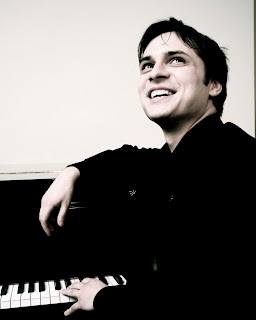
Sasha Grynyuk
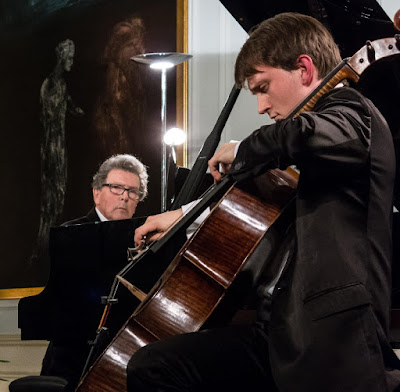
Howard Blake and Benedict Kloeckner performing together in 2012
Howard Blake remains best known for his music for the animated film The Snowman, with the song Walking in the air remaining inextricably linked with the composer's name. But his career has been far wider and varied than this, encompassing film music including Ridley Scott's The Duellists as well as a substantial body of concert music. But if you only know Blake from The Snowman and the film music, his concert music can be something of a surprise. Tonal and approachable in a tradition that links Blake to his original composition teacher at the Royal Academy of Music, Howard Ferguson, Blake writes large scale pieces of great depth and complexity. (Read my interview with Howard Blake). |
Reviews
Bold romanticism: Howard Blake's Piano Concerto and Diversions
Howard Blake Sleewalking, Piano Concerto, Diversions, Elegia Stravagante; Sophie Witte, Sasha Grynuk, Benedict Kloeckner, Nicolas Dautricourt, Royal Philharmonic Orchestra, Howard Blake; Cadogan Hall - Reviewed by Robert Hugill on Sep 7 2017
Howard Blake's piano concerto at the centre of an evening of his complex, and dramatic concertante works
The Royal Philharmonic Orchestra opened its 2017/18 season with a programme of music by Howard Blake, conducted by the composer. The centrepiece of the programme was Blake's Piano Concerto, originally commissioned by the Philharmonia Orchestra to celebrate the 30th birthday of Diana, Princess of Wales in 1991. Blake himself performed the taxing piano part at the premiere, this time he conducted with Sasha Grynyuk at the piano. Cellist Benedict Kloeckner was the soloist in Blake's Diversions for cello and orchestra (a work originally written for Maurice Gendron), and Kloeckner was joined by violinist Nicolas Dautricourt to give the premiere of Blake's Elegia Stravagante (Duo Concertante) for violin, cello and orchestra. The evening opened with a new version of Blake's Sleepwalking for soprano and string orchestra, with soprano Sophie Witte
Howard Blake remains best known for his music for the animated film The Snowman, with the song Walking in the air remaining inextricably linked with the composer's name. But his career has been far wider and varied than this, encompassing film music including Ridley Scott's The Duellists as well as a substantial body of concert music. But if you only know Blake from The Snowman and the film music, his concert music can be something of a surprise. Tonal and approachable in a tradition that links Blake to his original composition teacher at the Royal Academy of Music, Howard Ferguson, Blake writes large scale pieces of great depth and complexity. (Read my interview with Howard Blake).
Sleepwalking was originally written as a companion piece to Villa Lobos' Bachianas Brasileiras No. 5, for the same forces soprano and eight cellos. In his programme note Blake talked about finding the idea of eight cellos conjuring up the world of dreams, and his piece posits a scenario of a young woman asleep who then goes sleepwalking through various traumas before returning to sleep. Starting from atmospheric high sustained strings with the soprano vocalise over the top (the whole piece is wordless) the piece moved through seven highly contrasting movements, finally returning to the tranquillo of the opening. We had a series of highly varied moods evoked by instrumental writing very much in the English tradition of string music, from lyrical through to darker dramatic episodes. Witte sang with a lovely even tone, and a beautiful freedom at the top. A well put-together piece which did not quite take me on the journey the composer intended, and I would be interested to hear the original version.
Howard Blake's Piano Concerto is a large-scale dramatic work. It was in some ways the most conventional work in the programme, in three movements (the others were in seven or eight) and the only one to use classical sonata form. Christopher Palmer's 1991 programme note used the term Mozartian, but the composers who came to mind were Rachmaninov and Tippett; Rachmaninov for the big boned romanticism piece, particularly the piano writing, whilst Tippett for the way the piano texture sometimes eschewed showy bravura (but not complexity) and created a continuous texture which flowed over the orchestra..
The first movement started with an understated ear-worm on the piano alone, which Blake then developed into something more dramatic with tutti. Sasha Grynyuk was tireless, and indeed the piano solo got little rest in this movement. Even the cadenza eschewed virtuosity and was rather thoughtful and, unusually, ended the movement. The second movement started with solo piano chords accompanying solo violins and viola, until the tables were turned. The melodic piano line wandered expressively, but always with an elegant simplicity, and finally the whole ensemble moved the temperature up a notch and we got something richly romantic. The final movement started with a perky piano toccata, and developed into a series of variations with hints of jazz/blues. Often highly vigorous, the jaunty melody passed round the orchestra, but always with the piano to the fore over the top. Towards the end we had a simple return to the main theme in the piano before the big finish.
Blake's Piano Concerto is a terrific work, I enjoyed his recording of it (see my review) and I enjoyed this performance immensely. Sasha Grynyuk brought out the poetry in Blake's writing, and played the part with great flair. With longer rehearsal time, there would have been chance to iron out some of the issues of balance, Grynyuk's approach concentrated on poetry and nuance rather than sheer power, but overall he and the orchestra brought it off brilliantly and I hope it makes other orchestras interested.
After the interval the German cellist Benedict Kloeckner played Blake's Diversions. Originally written for Maurice Gendron (who encouraged Blake to add a cadenza and generally make the piece more virtuosic), the premiere was given by Steven Isserlis in 1989. But then it slept somewhat until Kloeckner played the version for cello and piano in the semi-finals of the European Broadcasting Union Awards in Bratislava (and went on to win the competition). Subsequently Kloeckner had played the work a number of times with Blake accompanying on the piano. But for this concert we heard the original orchestral version. It is based on an instrumental dance suite, with eight movements encompassing scherzo, march, waltz, aria serenade and sarabande, though in each Blake develops things in interesting ways. We started with Kloeckner's cello singing over an intense rather dark orchestral accompaniment. The scherzo was full of character, and toccata-lie, whilst the march developed into a really big romantic solo for the cello (and Kloeckner really made the piece sing here). The waltz was wistful and rather sly, with the cello line weaving in and out of the orchestra, and the serenade had the solo duetting with the oboe before moving into the perky sarabande which developed into a cadenza which had orchestral comments (including not quite raspberries from the bassoons). The finale was fast and furious, and completely joyous. Kloeckner clearly loves this work, and the virtuosity of the piece seems to suit him, he made everything magically engaging.
The final work in the programme was a new piece, Elegia Stravagante (Duo Concertante) for violin (Nicolas Dautricourt) and cello (Benedict Kloeckner). In seven movements, it started with violin and cello alone playing a melodic motif that sounded suspiciously like noodling, but in fact proved a fertile source for the musical inspiration of the piece. For much of the piece, the two soloists play together (in unison in some movements), and the effect was more like the structure of a baroque concerto rather than the large-scale battle of a full blown Romantic concerto.
During the work's seven movements, Blake brings back the original motif repeated in vastly different guises, creating some intense and full blown romantic moments, interspersed with episodes using different material such as a 'jazz fugue'. The two soloists often soared in unison (at one point at a 16th) over the orchestra, and the was a notably intense solo moment for Benedict Kloeckner, whilst a rather threatening orchestral passage rather evoked Walton. For the ending, there was a sense of the piece gradually unwinding, a moment for violin solo turned into a duet with the cello and the piece ended with just the two of them returning to the original motif.
This was a long and substantial concert, full of dramatic and complex music. It was a great pleasure to finally hear Blake's Piano Concerto live, as well as to experience the full orchestral colours in Diversions. Throughout Blake was supported by the sterling players of the Royal Philharmonic Orchestra, playing nearly two hours of complex and unfamiliar music, whilst the soloists encompassed the taxing demands of the solo parts in brilliant fashion.
Of course, no Howard Blake concert would be complete without The Snowman and as an encore Dautricourt and Kloeckner joined Blake and the orchestra for a version of Walking in the Air specially created for the occasion
Robert Hugill, Planet Hugill, 7/9/2017

